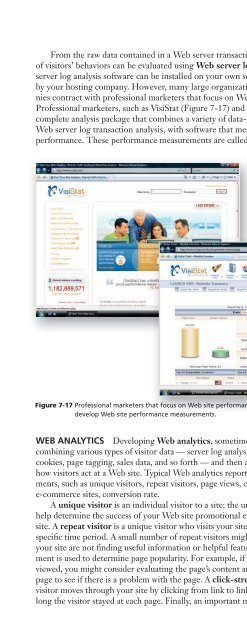(Shelly Cashman Series) Gary B. Shelly, H. Albert Napier, Ollie N. Rivers-Web design_ introductory concepts and techniques -Cengage Learning (2008)
You also want an ePaper? Increase the reach of your titles
YUMPU automatically turns print PDFs into web optimized ePapers that Google loves.
<strong>Web</strong> Site Maintenance <strong>and</strong> Evaluation 203<br />
From the raw data contained in a <strong>Web</strong> server transaction log, additional measures<br />
of visitors’ behaviors can be evaluated using <strong>Web</strong> server log analysis software. <strong>Web</strong><br />
server log analysis software can be installed on your own servers or might be provided<br />
by your hosting company. However, many large organizations <strong>and</strong> e-commerce companies<br />
contract with professional marketers that focus on <strong>Web</strong> site performance evaluation.<br />
Professional marketers, such as VisiStat (Figure 7-17) <strong>and</strong> <strong>Web</strong>Trends, often provide a<br />
complete analysis package that combines a variety of data-gathering <strong>techniques</strong>, including<br />
<strong>Web</strong> server log transaction analysis, with software that measures <strong>and</strong> reports on <strong>Web</strong> site<br />
performance. These performance measurements are called <strong>Web</strong> analytics.<br />
Figure 7-17 Professional marketers that focus on <strong>Web</strong> site performance offer products <strong>and</strong> services used to<br />
develop <strong>Web</strong> site performance measurements.<br />
WEB ANALYTICS Developing <strong>Web</strong> analytics, sometimes called <strong>Web</strong> metrics, involves<br />
combining various types of visitor data — server log analysis, eye-tracking studies, tracking<br />
cookies, page tagging, sales data, <strong>and</strong> so forth — <strong>and</strong> then analyzing that data to discover<br />
how visitors act at a <strong>Web</strong> site. Typical <strong>Web</strong> analytics reports contain a variety of measurements,<br />
such as unique visitors, repeat visitors, page views, click-stream analysis, <strong>and</strong>, for<br />
e-commerce sites, conversion rate.<br />
A unique visitor is an individual visitor to a site; the unique visitor measurement can<br />
help determine the success of your <strong>Web</strong> site promotional efforts at driving visitors to your<br />
site. A repeat visitor is a unique visitor who visits your site more than one time during a<br />
specific time period. A small number of repeat visitors might indicate those who are visiting<br />
your site are not finding useful information or helpful features. The page views measurement<br />
is used to determine page popularity. For example, if you have a page that is seldom<br />
viewed, you might consider evaluating the page’s content <strong>and</strong> retesting all the links to the<br />
page to see if there is a problem with the page. A click-stream analysis identifies how a<br />
visitor moves through your site by clicking from link to link <strong>and</strong> might also indicate how<br />
long the visitor stayed at each page. Finally, an important measurement for an e-commerce<br />
Q&A<br />
Q&A<br />
What are tracking<br />
cookies?<br />
Tracking cookies are<br />
small text files stored<br />
on a <strong>Web</strong> page visitor’s<br />
hard drive, usually<br />
without the visitor’s<br />
knowledge. Tracking<br />
cookies installed by<br />
<strong>Web</strong> marketers are<br />
used to monitor which<br />
sites the visitor visited<br />
<strong>and</strong> other visitor behaviors.<br />
Many visitors<br />
consider tracking<br />
cookies an invasion of<br />
privacy <strong>and</strong> most popular<br />
computer security<br />
software packages,<br />
such as Norton, locate<br />
<strong>and</strong> remove tracking<br />
cookies.<br />
What is page<br />
tagging?<br />
Page tagging is a<br />
technique used by <strong>Web</strong><br />
marketers to track<br />
visitors’ behaviors,<br />
similar to tracking<br />
cookies. A site publisher<br />
adds JavaScript<br />
tags to its <strong>Web</strong> pages.<br />
When a visitor views<br />
a page containing a<br />
tag, information about<br />
the visitor, similar to<br />
that recorded in a<br />
server log, is gathered<br />
<strong>and</strong> transferred to a<br />
database. The information<br />
is analyzed later by<br />
the professional <strong>Web</strong><br />
marketers <strong>and</strong> the site’s<br />
publisher.


